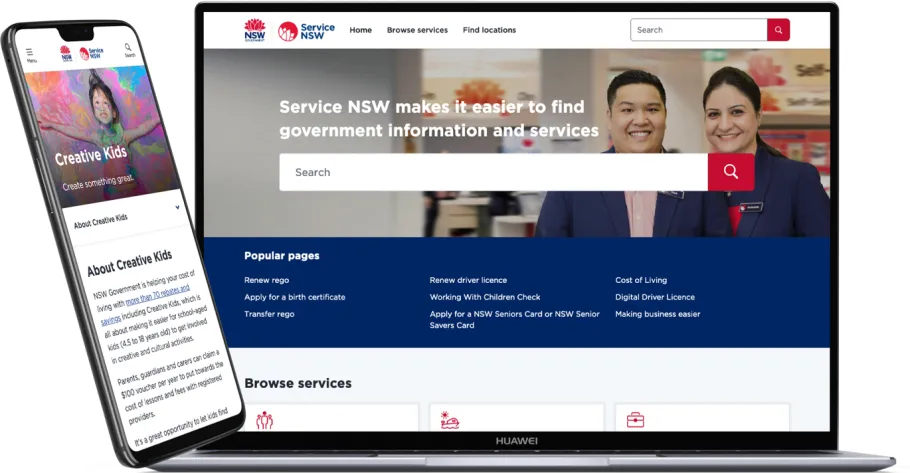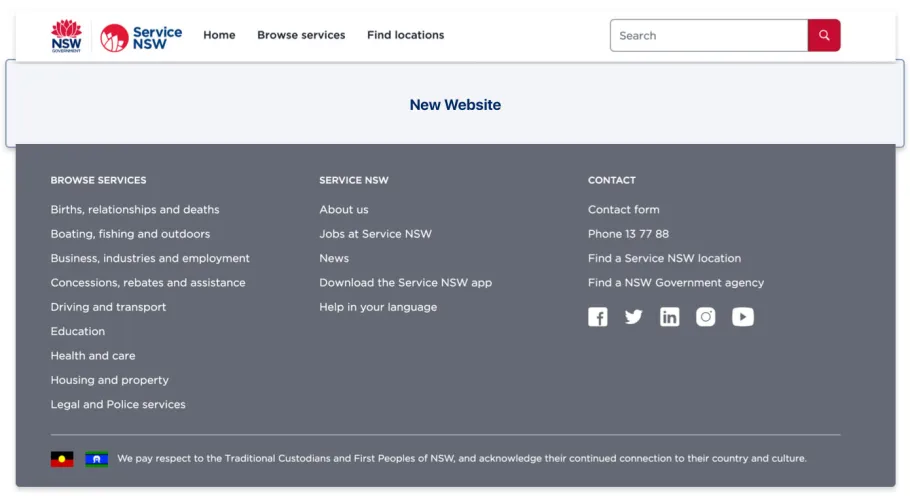In late 2012 Service NSW was established to provide a unified approach to customer service by the New South Wales government. This included new branding, building dedicated customer service centres and call centres, and the development of a digital services portal.

The organisation has since expanded to more than 180 locations with over 1200 government transactions available via the website. It has served 118.7 million user sessions since 2013. The importance of Service NSW was cemented in 2019 when a Minister for Customer Service role was created to drive digital service transformation and citizen engagement.
History
PreviousNext has partnered with Service NSW since its inception in 2012 when we were appointed to build the initial website in Drupal 7. This led to an ambitious push to launch a functional platform in July 2013 that would serve as both the customer facing website and kiosk interface for users at service centres.
Once the site was launched, PreviousNext was retained by Service NSW to support and enhance the platform whilst undertaking a range of additional projects including the NSW Police Community Portal and internal tools, such as the corporate intranet.
In parallel with our development services, Service NSW has kept pace with its rapidly expanding website traffic by hosting on PreviousNext’s auto-scaling cloud hosting platform, now serving over 10 million page views per month.
Growth & Challenges
The success of the Service NSW model has led to more than 850 transactions being added to the website since it launched in 2013. User expectations have also become more sophisticated in that period as digital service delivery has grown ubiquitous and mobile devices have become the primary means of interaction online.
While the original Drupal 7 website was able to accommodate this growth, it became apparent in 2018 that the platform would benefit from a full redesign and a migration to Drupal 8.
Service NSW’s goals included:
- Improving the user experience
- Modernising the technical platform
- Having the flexibility to share design components, content and code with other teams
This would be driven by an agile and user-centric process involving customers, staff and stakeholders.
User-centred redesign

Service NSW conducted a comprehensive user research and website analytics program to assess how users were using the site versus how they wanted to use it. This provided key insights on user expectations, the role of search, intuitive content structure, as well as consistency of user experience between websites that were linked to Service NSW.
In parallel with the user research being conducted, a multi-disciplined product team was formed within Service NSW to undertake the redesign and redevelopment of the website. PreviousNext’s developers formed a core part of this team, which also included User Experience Designers, Content Editors, a Product Manager and an Agile Delivery Specialist.
Moving to Drupal 8
The redesign was viewed as a perfect opportunity to upgrade Service NSW’s Content Management System (CMS) from Drupal 7 to Drupal 8 and take advantage of its modern content management tools. This included Drupal 8 supporting:
- A truly mobile-first design approach (over 60% of users now access the site on mobile devices)
- Simplified but powerful content editor workflows and tools
- Richer user experiences with React front end interfaces and an open API to deeply integrate with third party systems
Re-usable design components

The Service NSW website provides connections to other branded landing pages and transactions so the need for a consistent user experience as users navigate between services is critical. PreviousNext developed a reusable branded header and footer with navigation items that can be managed centrally and embedded on any linked website. For example, a navigation item can be updated once, then automatically synchronised across multiple websites.
Sajari Search

One of the key user research learnings was that users prefer a Google-like search experience to find content within the Service NSW site. Following a comparative evaluation of integrated search products, Sajari site search was selected for its powerful AI-powered platform. Sajari integrates seamlessly with Drupal 8 and utilises machine learning to continually optimise search results. It also provides an interface for Service NSW to customise results based on real time analytics of users’ search behaviour.
Decoupled front end & JSON:API
Using the React Javascript library, PreviousNext was able to de-couple the user interface from the CMS for key functions within the Service NSW website. This includes the Service Centre Locator that provides users with the ability to search over 180 locations via a mobile-optimised interface. All of the location and opening hours data is shared via a JSON:API, allowing other NSW government websites to leverage this service for their own purposes.
Link management repository
The Service NSW website operates as a ‘single source of truth’ for many NSW government agencies. The website has more than 40,000 links to external references and services. To centrally manage these links, PreviousNext built a Link Management Repository, providing the ability to review, update and delete individual links as required. This system is open to any other NSW Government website to use on their own Drupal websites.
Custom dashboards
Given the critical importance of the website to Service NSW’s operations, their product and editorial teams need infrastructure performance, scheduled publishing and real time user analytics insights. PreviousNext developed a suite of custom dashboards within Drupal 8 that amalgamate information based on specific user roles within Service NSW’s teams for this purpose.
Custom advertising management & analytics tracking
As the NSW Government’s most visited website, a range of display advertising is offered to other government agencies on the Service NSW website. For this purpose, PreviousNext developed a custom advertising management solution that can be targeted and tracked as required. This is in addition to a comprehensive Google Tag Manager implementation that can track all manner of user interactions within the website.
Staged rollout & CDN integration
The scale and visitor traffic of Service NSW meant that it was preferable to release new functionality on Drupal 8 while large sections of the site were still running on Drupal 7. PreviousNext developed a custom solution to hot-swap between site sections whilst providing a seamless user experience. While this resulted in the page count increasing due to enhanced user engagement, the demand on infrastructure reduced due to more content being served via advanced Content Delivery Network (CDN) integration. This approach also allowed the Service NSW editorial team to modify the site and see their changes reach customers immediately with intelligent cache invalidation – overriding specific content items that would otherwise require a full server cache refresh.
Managed cloud hosting
Service NSW has hosted its websites on PreviousNext’s cloud platform since 2015. The platform uses advanced containerised hosting technologies to provide fully automated scalability based on current visitor traffic. The platform has also been designed specifically for client-side and vendor development workflows, providing a very high degree of efficiency and collaboration.
The hosting platform enabled a staged rollout of features. This approach proved crucial to the success of the project as the team was able to fine tune the application with real user interactions during the development phase and seamlessly go live when a feature was complete.
Continuous improvement
While the new Service NSW website launched in June 2019, PreviousNext is retained to provide ongoing support, maintenance and enhancement services for the platform. Through Agile delivery methods, a backlog of prioritised features is maintained and scheduled for development under an ongoing services model, while major projects are separately budgeted. This provides Service NSW with the consistency of a dedicated team that understands the intricacies of the platform.